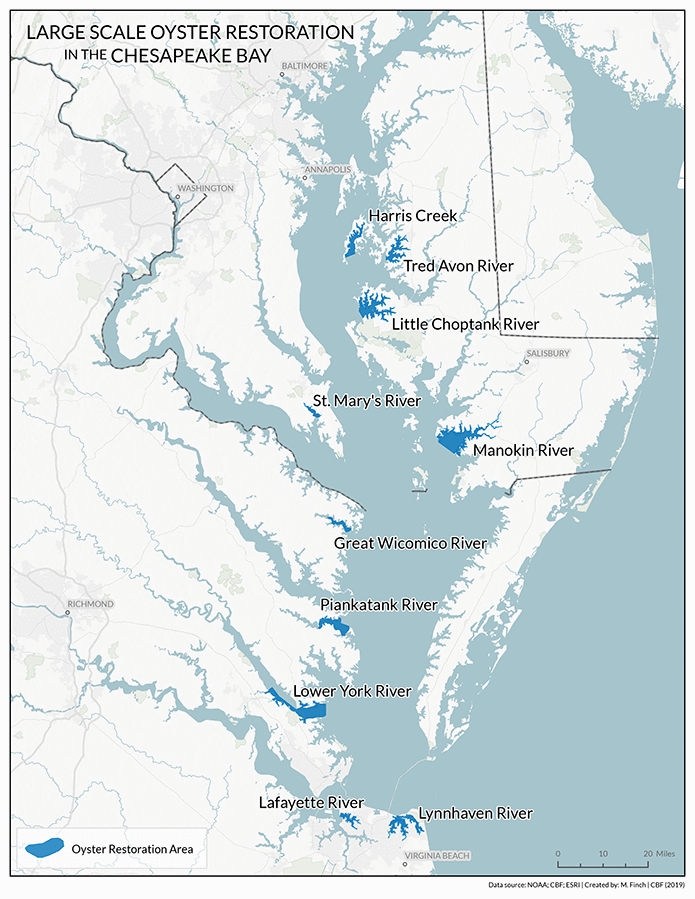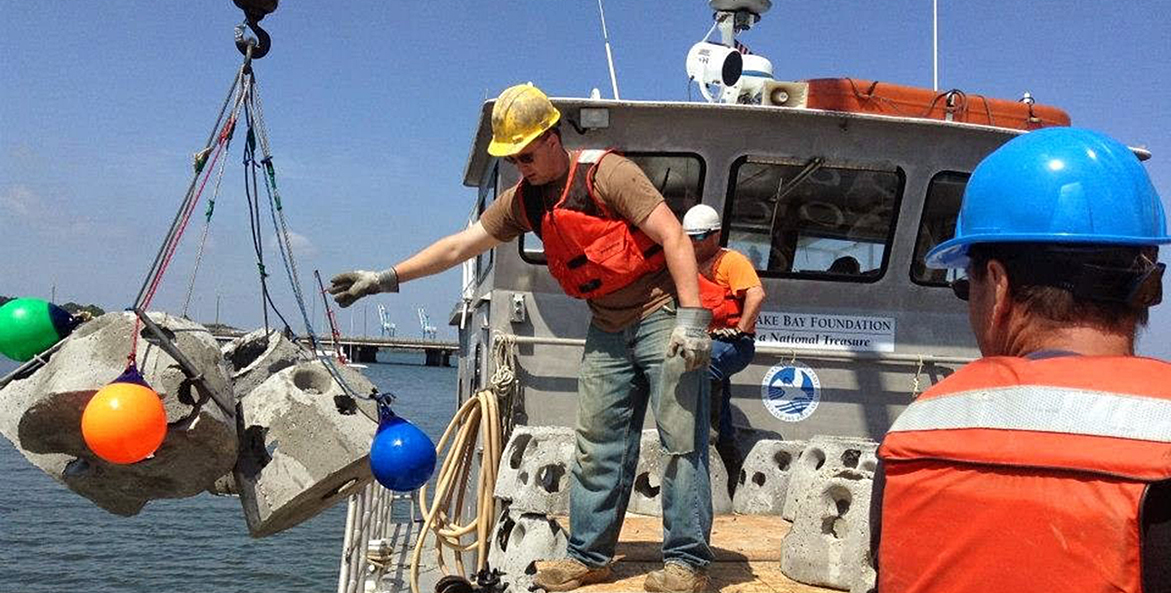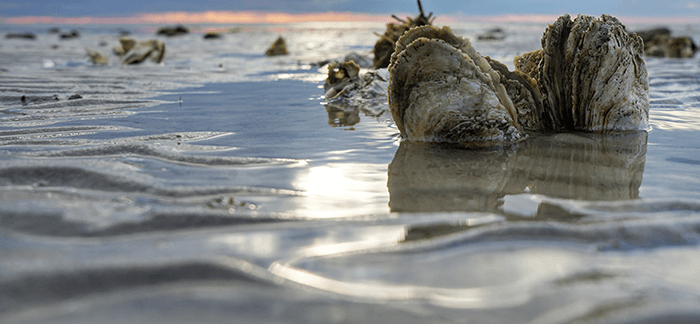Back in 2013, Lieutenant Commander Brian Davis thought volunteering to restore oysters in the Lafayette River would be a great way to get outside and away from his office at Naval Station Norfolk for the day. Twelve years later, he’s a dedicated oyster gardener and enthusiastic evangelist for oyster restoration—he even has a personalized license plate that reads “BAYOYS”.
“I love what the oyster does to the waters,” said Davis, who has since retired from the Navy. “It’s just seeing the power of this little bivalve to filter [water], to provide habitat for crabs, to encourage seagrass growth, to help with the dead zones. You know, it’s just one little mollusk.”
Davis takes pride in the small part he’s played, as a Chesapeake Bay Foundation (CBF) volunteer, in reviving the Lafayette. Once a polluted urban river that barely supported life, it is now home to 82 acres of thriving oyster reefs and a diverse array of marine life, including seahorses, dolphins, crabs, speckled trout, shrimp, and striped bass.
...if the federal well goes dry, then a lot of these benefits will go away.
The Lafayette, deemed restored in 2018, was the first Virginia river of the 10 Bay tributaries to meet the 2025 deadline for achieving large-scale oyster habitat restoration goals set in the 2014 Chesapeake Bay Watershed Agreement. The projects collectively make up the largest and most successful oyster restoration effort in the world.
But while monitoring of the restored reefs shows incredible results, the federal agencies integral to this success are facing major cuts in funding and staff, putting at risk one of the brightest and most critical achievements for Bay restoration.
“This is a natural part of the Chesapeake Bay that was overfished and died off from diseases…that is making a comeback. And we are seeing the results of the comeback in the form of clearer water, more seagrasses, more diverse fish in the water, and the seahorses and the dolphins,” Davis said. “But if the federal well goes dry, then a lot of these benefits will go away.”
The Effort to Save the Bay’s Oysters
Oysters are a keystone species essential to restoring the health and productivity of the Bay and its waterways. Unfortunately, more than a century of overharvesting, destructive harvesting practices, pollution, and disease have left this once abundant shellfish at a fraction of its historical population.
The work to restore the Bay’s oyster reefs and their benefits at scale is unprecedented. It is led by the National Oceanic and Atmospheric Administration (NOAA), which maps available restorable river bottom, determines how many oysters are needed, and funds the production and planting of baby oysters.
The U.S. Army Corps of Engineers, which provides reef-building assistance or issues construction permits for other partners, is the other key federal government player. Both agencies monitor how restored reefs are doing at three and six years after restoration.
Maryland and Virginia state agencies, municipalities, academic institutions, and nonprofits also contribute funding and do restoration work. But NOAA and the Army Corps provide the foundational investment—$10.45 million in the current fiscal year—that is essential to the effort’s success.

Federal Investment Accelerates Community Efforts
Scattered restoration projects that were too small to have a systemwide effect on the Bay were the norm before the Army Corps came out with its comprehensive Native Oyster Restoration Master Plan for the Chesapeake Bay in 2012.
Emma Green Ewing, executive director of the St. Mary’s River Watershed Association in Southern Maryland, noted the transformational impact of large-scale oyster restoration for community groups like hers.
“We’ve been working on our five-acre reef site restoration project…for 10 years and that was just five acres and tons of resources, time, energy, money into that.”
NOAA, the Army Corps, the Maryland Department of Natural Resources, and the non-profit Oyster Recovery Partnership were “able to come in in just two years and [do] five times as much as we were able to do” she said.
Large-scale work in the upper portion of the St. Mary’s River began in 2021 and concluded in 2022, adding 25 restored acres to 35 acres of existing healthy reefs.
Ewing said she has heard from recreational anglers that the fishing is “way better” in the St. Mary’s River since restoration started.
“The level of investment is just so much bigger than our community organizations can do on our own. And these projects help support community organizations as well.
“Having [their] backing is huge,” Ewing added. “And if they’re going to say that this is a good idea, that means a lot.”
Downstream Benefits of Oyster Restoration
The success of the NOAA-led large-scale restoration model, if applied to more of the Bay’s tidal rivers, offers many reasons for optimism. In our 2024 Hope on the Half Shell report, CBF called for expanding restoration work to an additional 20 tributaries by 2035.
The restoration work is limited to oyster sanctuaries, which are closed to commercial harvest. But restored reefs in the off-limits areas also benefit commercial and recreational fishing and the hospitality, recreation, and tourism businesses they support.
Oysters filter nitrogen, phosphorus, and sediment that pollute the water and produce “dead zones” that lack enough oxygen to support life.
Their reefs provide habitat for an array of Bay species, including blue crabs, striped bass, and menhaden, vital to the Bay region’s outdoor recreation and seafood industries. They also naturally protect the shoreline from erosion by stabilizing the river bottom beneath them and absorbing the potentially destructive energy that waves generate. And reefs absorb atmospheric carbon in the oysters’ shells, helping to mitigate climate change and its destructive effects.
Ewing said she has heard from recreational anglers that the fishing is “way better” in the St. Mary’s River since restoration started.
“These sanctuaries are also helping the public fishery downstream,” Ewing added, when oyster larvae from sanctuary reefs float down the river and attach to reefs in the public fishery. The state of Maryland designated the Upper St. Mary’s River as an oyster sanctuary in 2010.
Oyster aquaculture, which is allowed in oyster sanctuaries, has flourished and fishing has also improved in the Lafayette River and nearby Elizabeth River as the native oyster population has revived, Davis said. The Eastern Branch of the Elizabeth River was the second Virginia river targeted for restoration to meet its habitat goals, in 2021.
The Elizabeth River was added as a "bonus" tributary in 2019 to the original 10 chosen for restoration in the Chesapeake Bay Watershed Agreement of 2014.
“Oysters are contributing to the fishing,” Davis said. “They’re contributing to the actual oyster income for the state of Virginia. Just put the oyster aquaculture in all these rivers. They hadn’t been able to be fished before. Now there’s oyster habitat that is booming,”

Washington, D.C. Communications & Media Relations Manager, CBF
[email protected]
202-793-4485



